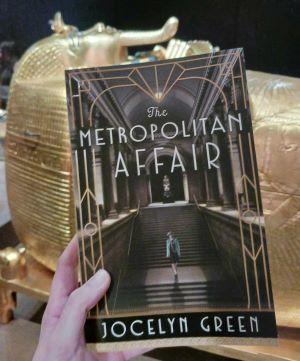
Last weekend I had the opportunity to explore an exhibit on King Tut's tomb and treasures while in Columbus, Ohio! This exhibit was hosted by Cosi and will remain open until September 4, 2023. Given the King Tut fever that served as the backdrop and catalyst for my novel, The Metropolitan Affair, I couldn't resist visiting--and of course I took along a copy of the book. (Quick recap: King Tut's tomb was discovered in November 1922. The inner tomb was finally reached and excavated months later, in early 1923. When my novel takes place in 1925, King Tut fever was all the rage. Read more about that here.)
Want a glimpse inside? Let's go!
But first, to be clear, all of these are reproductions. None of these are originals, which actually fits so perfectly with my novel's theme of fakes vs. genuine artifacts. I looked for a book in the gift shop on the making of this exhibit, because how fascinating would that be! Alas, I found no such guide. But it's truly amazing to see all these pieces. I was so enthralled with the history it represented, I forgot a few times that what I was looking at wasn't original. There is a line from The Metropolitan Affair that says, "People see what they want to see." While touring the displays, that came to mind a few times. It's easy to imagine how the art of the artifact becomes larger than the fact. (See what I did there?)
I want to show you a few things that my curator protagonist, Dr. Lauren Westlake, points out in the novel. In one section, she is pointing out how amateur forgers might slip up and make mistakes by "correcting" the human anatomy of paintings. For example, let's look at this painting from inside the tomb.

Notice that males are painted with red-brown skin tones, and the female is painted with yellow skin tone. This was the standard rule.
Next, look at the woman's hands. See anything unusual about them? Here's a closer-up look, below.

Both thumbs are positioned above the rest of the fingers, which means her right thumb doesn't match the natural position of thumbs. This is another hallmark of Egyptian art a forger might miss. Now take a look at the feet, below.

No matter how the viewer looks at the feet, we always see the big toe side foremost, of both feet.
And then, of course, there are the distinctive eyes:

Even on the profile of people, the eyes are painted as though you are looking at them straight on, not from the side.
So there you have it--a few illustrations of what Dr. Westlake explains in The Metropolitan Affair.
Now let's take a look at King Tut's treasures! I'll just show you a small sampling. Let's start with the shrines. There were four shrines, each one nesting inside a larger one. Inside the smallest shrine was the sarcophagus, and inside the sarcophagus was another nesting set of three coffins. The inner coffin holds King Tut's mummy.
The picture below shows the third largest shrine on the right, with the smaller two shrines and the sarcophagus stretching out the left.

Below, you see the largest shrine with its doors open. The coffins, sarchophagus and three other shrines fit inside this one.

The drawing below is an enlargement of the diagram Howard Carter made. You can see how everything fit together, and you can also see where some treasures were tucked between the shrines.

The photo below offers a closer-up view of one of the shrines.

Below, is the sarcophagus that held the coffins:

Now for the coffins! You see below the outer coffin (mostly gold) and the middle coffin in the foreground. The originals were made of cypress wood with gold overlays and gemstones.

Here is a closer-up view of the middle coffin, below.

Now on to the inner coffin. The original was pure gold and weighs 234 pounds.They displayed this reproduction with its cover off and lying beside it so you can see how the mummy would have been buried inside it.

Now for what is probably the most iconic artifact associated with King Tut: the funerary mask.

The original was laid over the mummy's head and shoulders, and weighs 25 pounds. It's an idealized likeness of the young king. Many consider this to be the centerpiece of all Tut's treasures. On the forehead of the headdress, the emblems of the vulture and serpent represent Upper Egypt and Lower Egypt, respectively.
The pharaoh was buried with plenty of jewelry, including the collars below.

The mumified feet were encased in these gold sandals and toe sheaths, below.

How about another shrine? This one, on the left of the photo below, holds King Tut's canopic jars, pictured at right.

You may already know that canopic jars were what the ancient Egyptians used to store human organs of mummies (but not the brain, which they discarded). Most of the time, the jars were simply jars with lids that depicted human heads or heads of various gods. Not so with Tut's! Take a look below. After pulling up the lid, there was a mini-coffin in a vertical compartment for each of the king's organs.


These little coffins in the picture above represent the canopic jars that were tucked inside the alabaster box.
There was so much more to see, but I will leave you with his throne and footstool. The couple depicted on the chair back is King Tut and his wife.

Thanks for coming along with me! Did anything in this post surprise you?
*Please note: I moderate comments to keep the spam at bay. So your comment will show up after I approve it, which I will do as soon as I can. Thanks!



Comments
Wow. Such detail. it's so
The attention to detail is
This was fabulous and
Learning about the canopic
Learned so many new things.
Yes the brain being thrown
Thank you for this "peek"
I was surprised to read how
In answer to your question,
I have wanted to see exhibits
It's amazing how much
I remember visiting the
The coffins and other items
what a treasure! I was
Wow, I was impressed by the
So many things surprised me
I thought the way the thumbs
Interesting about the shoes
What an amazing culture!
I remember going to this as a
I saw this exhibit many years
All that gold!
I was amazed at everything. A
That's so cool
Thank you for the history
The amount of money/gold that
Fascinating history and
Such a different time and
I had never paid attention to
It just surprises me all the
I know absolutely nothing
So much of this was
My sister was obsessed with
I’ve always been a fan of
Add new comment